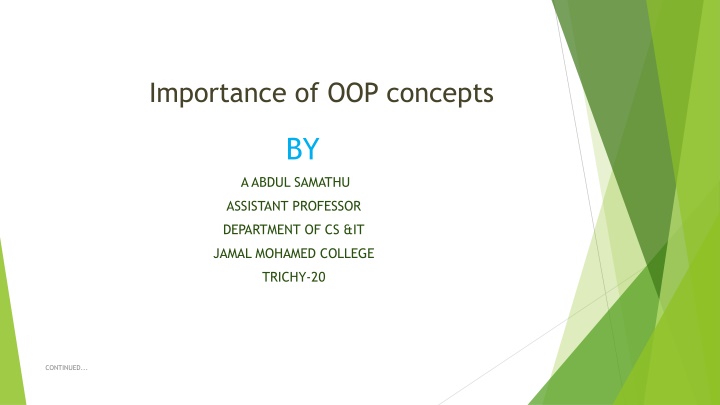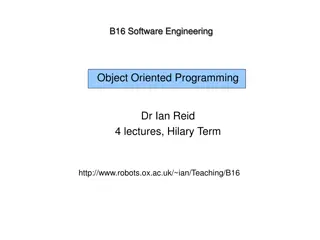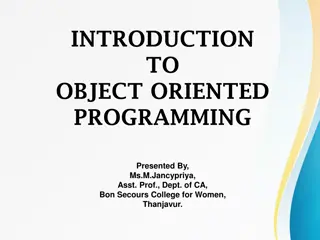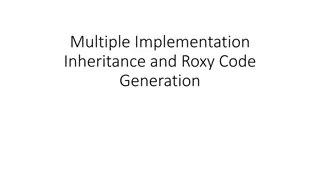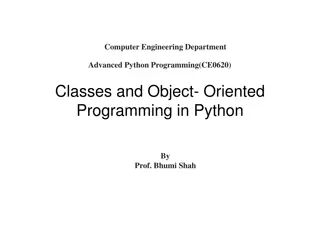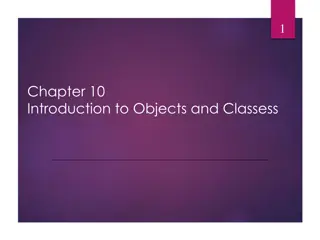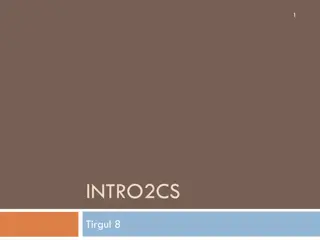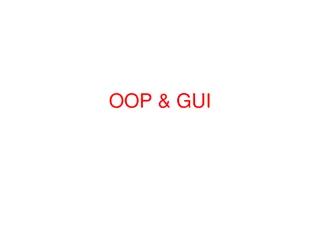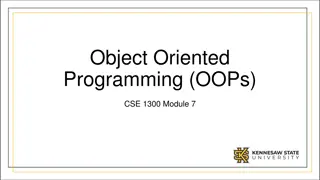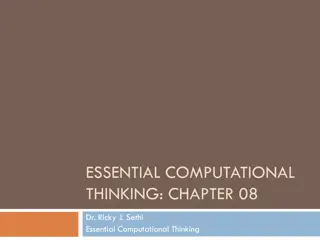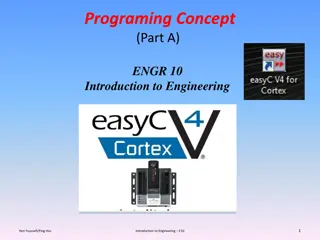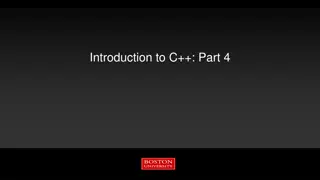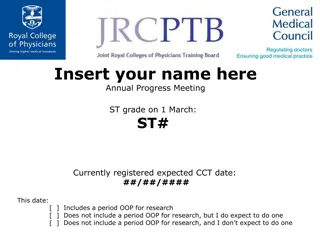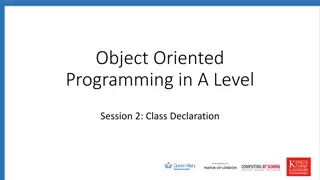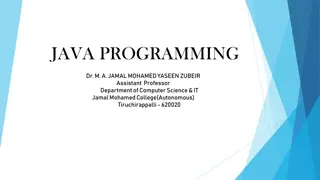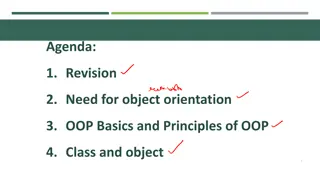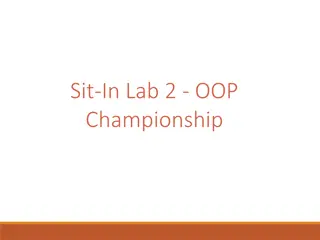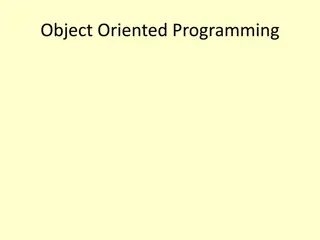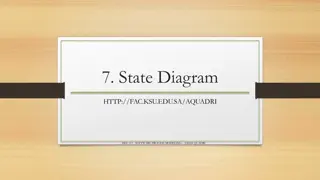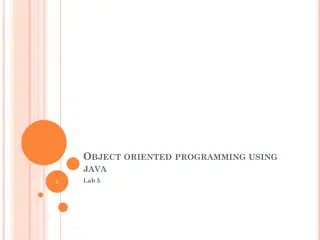Importance of OOP concepts
Object-Oriented Programming (OOP) is essential for modularizing programs, creating encapsulated entities called objects, and enabling functions of one object to access functions of others. OOP offers a structured approach to problem-solving by combining data with functions that operate on it. C++ stands out as a language with incremental object-oriented features and support for polymorphism, encapsulation, and inheritance. Unlike procedure-oriented languages, OOP restricts data access, promotes data security through data hiding, and allows dynamic binding. Explore the significance of OOP concepts for efficient program development.
Download Presentation

Please find below an Image/Link to download the presentation.
The content on the website is provided AS IS for your information and personal use only. It may not be sold, licensed, or shared on other websites without obtaining consent from the author.If you encounter any issues during the download, it is possible that the publisher has removed the file from their server.
You are allowed to download the files provided on this website for personal or commercial use, subject to the condition that they are used lawfully. All files are the property of their respective owners.
The content on the website is provided AS IS for your information and personal use only. It may not be sold, licensed, or shared on other websites without obtaining consent from the author.
E N D
Presentation Transcript
Importance of OOP concepts BY A ABDUL SAMATHU ASSISTANT PROFESSOR DEPARTMENT OF CS &IT JAMAL MOHAMED COLLEGE TRICHY-20 CONTINUED...
OBJECT ORIENTED PROGRAMMING CONCEPTS The motivation factor in invention of oop is to remove some flaws encountered in pop. Oop treats as data is more important, does not allow it to flow freely. It bind data with its function that operate on it and protects from access from outside functions. OOP allows decomposition of a problem into a number of entities called objects , and then builds data and its functions around these objects. Functions of one object can acess the functions of other objects We can define object oriented programming as an approach that provides a way of modularizing programs by creating partitioned memory area for both data and functions that can be used as templates for creating copies of such modules on demand. CONTINUED...
Overview of C language: 1. C language is known as structure oriented language or procedure oriented language 2. Employs top-down programming approach where a problem is viewed as a sequenceof tasks to be performed. All program code of c can be executed in C++ but converse many not be possible 3. Function overloading and operator overloading are not possible. 4. 5. Local variables can be declared only at the beginning of the block. CONTINUED...
6. Program controls are through jumps and calls to subroutines. 7.Polymorphism, encapsulation and inheritance are not possible. For solving the problems, the problem is divided into a number of modules. Each module is a subprogram. 8. Data abstraction property is not supported by procedure oriented language. 9. Data in procedure oriented language is open and can be accessed by any function. CONTINUED...
Overview of C++ language: C++ was developed by Bjarne Strustrup in 1980s 1983 named as C++ 1997 ANSI Standardised. 1. C++ can be considered as an incremental version of c language which consists all programming language constructs with newly added features of object oriented programming. 2. C++ is structure(procedure) oriented and object oriented programming language. ( means that it is partial object oriented programming language.) 3. The file extension of C++ program is .CPP 4. Function overloading and operator overloading are possible. 5. Variables can be declared in inline i.e when required 6. In c++ more emphasis is give on data rather than procedures CONTINUED...
7. Polymorphism, encapsulation and inheritance are possible. 8. Data abstraction property is supported by c++. 9. Data access is limited. It can be accessed by providing various visibility modes both for data and member functions. there by providing data security by data hiding. 10. Dymanic binding is supported by C++. 11. It supports all features of c language. 12. C++ can be said as superset of C. CONTINUED...
Difference Between Procedure Oriented Programming (POP) & Object Oriented Programming (OOP) Procedure Oriented Programming Object Oriented Programming program is divided into small parts called functions. program is divided into parts called objects. Importance is not given to data but to functions as well as sequence of actions to be done. Compilation follows Top Down approach. Importance is given to the data rather than procedures or functions because it works as a real world. OOP follows Bottom Up approach. It does not have any access specifier. OOP has access specifiers named Public, Private, Protected, etc. Data can move freely from function to function in the system. objects can move and communicate with each other through member functions. CONTINUED...
To add new data and function in POP is not so easy OOP provides an easy way to add new data and function. Most function uses Global data for In OOP, data can not move easily from function to function,it can be kept public or private so we can control the access of data. sharing that can be accessed freely from function to function in the system. OOP provides Data Hiding so provides more security. It does not have any proper way for hiding data so it is less secure. In OOP, overloading is possible in the form of Function Overloading and Operator Overloading Overloading is not possible. Example of Object Oriented Programming are : C++, JAVA, VB.NET, C#.NET. Example of Procedure Oriented Programming are : C, VB, FORTRAN, Pascal. CONTINUED...
Basic Concepts of object oriented programming: 1. Object 2. Class 3. Encapsulation 4. Data abstraction 5. Polymorphism 6. Inheritance 7. Dynamic binding 8. Message passing CONTINUED...
Objects: Objects are the basic run-time entities. It consists of two things i) Data (attributes) ii) Functions (Usages) Object Student DATA name rollno Functions Read Display CONTINUED...
Class: A class is a coolection of objects of similar types. For example: apple, mango are members ( objects ) of the class Fruit. In another way a class is a user defined data type. We can create objectes using class name Example : fruit apple,mango; CONTINUED...
Encapsulation: Wrapping of data and functions together as a single unit is known as encapsulation. By default data is not accessible to outside world and they are only accessible through the functions which are wrapped in a class. prevention of data direct access by the program is called data hiding or information hiding CONTINUED...
Data abstraction : Abstraction refers to the act of representing essential features without including the back ground details or explanation. Classes use the concept of abstraction and are defined as a list of attributes. They encapsulate all essential properties of the object that are to be created. The attributes are called as data members as they hold data and the functions which operate on these data are called as member functions. Class use the concept of data abstraction so they are called abstract data type (ADT) CONTINUED...
Polymorphism: Polymorphism comes from the Greek words poly and morphism . poly means many and morphism means form i.e.. many forms. Polymorphism means the ability to take more than one form. For example, an operation have different behaviors in different instances. The behavior depends upon the type of the data used in the operation. Different ways to achieving polymorphism in C++ program are: 1) Function overloading 2) Operator overloading CONTINUED...
Inheritance: Inheritance is the process by which one object can acquire the properties of another. Inheritance is the most promising concept of OOP, which helps realize the goal of constructing software from reusable parts, rather than hand coding every system from scratch. Inheritance not only supports reuse across systems, but also directly facilitates extensibility within a system. Inheritance coupled with polymorphism and dynamic binding minimizes the amount of existing code to be modified while enhancing a system. When the class child, inherits the class parent, the class child is referred to as derived class (sub class) and the class parent as a base class (super class). In this case, the class child has two parts: a derived part and an incremental part. The derived part is inherited from the class parent. The incremental part is the new code written specifically for the class child. CONTINUED...
Dynamic binding: Binding refers to linking of procedure call to the code to be executed in response to the call. Two types of bindings are: i) Compile time( static) binding ii) Runtime( Dynamic ) binding In Compile time binding , linking is done at the time of compilation for example: int a =10; the value 10 is associated at the time of compilation. Dynamic binding(or late binding) means the code associated with a given procedure call in not known until the time of call at run time. Example: function call CONTINUED...
Message passing: An object oriented program consists of set of object that communicate with each other. Objects communicates with each other by sending and receiving information . A message for an object is a request for execution of a procedure and there fore invoke the function that is called for an object and generates result For Example: object.display(name); CONTINUED... Interface Message Information
Benefits of object oriented programming (OOPs) Reusability: In OOP s programs functions and modules that are written by a user can be reused by other users without any modification. Inheritance: Through this we can eliminate redundant code and extend the use of existing classes. Data Hiding: The programmer can hide the data and functions in a class from other classes. It helps the programmer to build the secure programs. Reduced complexity of a problem: The given problem can be viewed as a collection of different objects. Each object is responsible for a specific task. The problem is solved by interfacing the objects. This technique reduces the complexity of the program design. Easy to Maintain and Upgrade: OOP makes it easy to maintain and modify existing code as new objects can be created with small differences to existing ones. Software complexity can be easily managed. CONTINUED...
Message Passing: The technique of message communication between objects makes the interface with external systems easier. Modifiability: it is easy to make minor changes in the data representation or the procedures in an OO program. Changes inside a class do not affect any other part of a program, since the only public interface that the external world has to a class is through the use of methods. CONTINUED...
